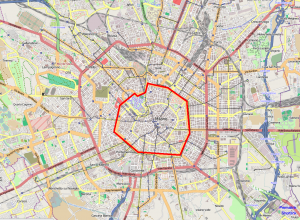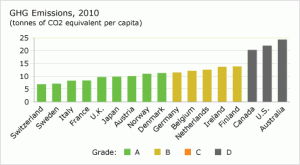Harrisburg is the the capital city of Pennsylvania, U.S. It has a population of 49,673 and it is the 9th largest city in Pennsylvania [1]. Harrisburg was rated as the 2nd best city in the U.S. to raise families by Forbes Magazine[1], an American business magazine well-known for its lists[2]. Before achieving this fame, Harrisburg, more than 20 years ago, was ranked as the most distressed city in the U.S[3]. The significant changes in the city’s development is largely attributed to the tax reform initiated by Mr. Stephen Reed back in 1980[4] as a member of the Pennsylvania House of Representatives, who later on became the Mayor of the city of Harrisburg from 1982 to 2010[5].

Source: ASPA National Weblog[9]
Two-tier tax rate policy
Before this tax reform, the traditional property tax was used in Harrisburg with which both the land and the buildings / improvements on the land was charged at the same rate. After the reform, the tax rate on the land was increased and the tax rate on the buildings /improvements was decreased. The initial ratio was 2:1 when the two-tier tax rate (land tax rate : building tax rate) was introduced. As the years passed by, the ratio has been adjusted and always been with a high rate on the land and a low rate on the buildings / improvements; in the recent years, the ratio has been increased to 3:1, 4:1, 5:1, 6:1 subsequently and stayed at 6:1 (0.024 : 0.004 in actual rates)[4][6]. They ultimately want to eliminate the tax on the buildings / improvements and turn the taxation into a pure land value tax. Like before, the tax revenues will go to city development in infrastructures, public facilities such as schools and hospitals, etc.
The Purposes of the Policy
It’s believed that the traditional property tax taxing both the land and the building the same discourages the land owners to invest in the development of the land or the construction on it. As the higher value of the buildings / improvements, the higher tax you will need to pay to keep them. You may just want to leave your old house as it is because you will be penalized by renovating / improving it (higher value, higher tax to pay). Likewise, such a property tax discourages vertical development and inevitably encourages urban sprawl. Land supply is limited, therefore the use of each unit of land should be maximized. With the two-tier tax rate policy, it is aiming for city revitalization by incentivizing urban renewal and curbing urban sprawl, specifically as the follows according to Reed[4]:
- induce the highest and the best use of the land
- reward the better use of the land
- discourage land being left vacant or unused
- encourage vertical and high rise development
- discourage spread and preserve natural areas and open space areas such as parks, historic sites, etc.
Historical Outcomes
The effect of this tax policy has been noticeable since 1982 and it’s described by Reed, up to 2010[4]:
- 4.8 billion worth of investments occurred
- taxable properties went from $212 million to $1.6 billion
- residential units sharply increased
- vacant structures fell by 80%
- crime rate dropped by 28%
- thousands of new jobs were created
Overall, the two-tier tax rate policy seems effective in encouraging development and population densification as well as achieving the stated purposes. However, the coverage of the tax reduces the effectiveness of this policy where the land and properties owned by the state and non-profit bodies are exempted[3]. The exemption is the same as before the policy change. For example, the churches don’t need to pay this tax and, thus, there’s virtually not much incentive for them to make their best use of the land, at least, compacted construction is not necessary. Likewise, the state-owned land might just be left vacant as before.
Why It Works
It is logical that the two-tier tax rate policy can achieve the densification purpose. After the reform, the tax on land was increased and the tax on the buildings /improvements was decreased. With that in place, the opportunity cost to keep a vacant land becomes relatively high. You will more likely to sell it or develop on it. Likewise, it attracts investments. If you decide to build on the land, now that the tax rate on the building is so low, you will want to maximize your return and building higher levels that is within your budget. When you rent out the units, because of the reduced costs from the taxes on the buildings, you can rent out the units for lower prices compared to when the traditional property tax was in place. This would also help provide more affordable housing to the residents. However, as more development comes in, the land values will be driven up, resulting in high taxes for the landowners. Therefore, the reduction in costs might eventually be cancelled out and the residents might still pay similar amount of rents as before.
On the other hand, the commercial investors might opt for the land in the rural areas where the land value is lower, thus a lower tax. However, in this case, it is restricted. According to Pennsylvania’s zoning legislation[7], the rural ares are for (although not limited to) agriculture, timbering, mining, recreation, tourism etc. and the development of infrastructures are limited. Together with such a zoning legislation, the intended effects of the policy can be and have been captured[8].
Conclusion
The two-tier rate tax on the land and the buildings / improvements in Harrisburg has been quite successful in achieving its purposes of urban revitalization in the City of Harrisburg. It has encourages the compact city development where buildings are densely and vertically built in the city center to maximize the land use per capita and the increase in population density follows. Although the policy doesn’t aim to decrease crime rate, etc., the increasing tax revenues do in a way support the development of the public and social sectors of the city and improve the overall living standard of the city and benefit the residents. The early investors, landowners renters are probably much better off under the effect of the policy, as the land value increases and increases the amount of taxes, the benefits are diminishing. However, the city as whole is still better off.
References:
1. Wikipedia. (Mar, 2013). Harrisburg, Pennsylvania. Retrieved from http://en.wikipedia.org/wiki/Harrisburg,_Pennsylvania
2. Wikipedia. (Mar. 2013). Forbes. Retrieved from http://en.wikipedia.org/wiki/Forbes
3. Hartzok, Alanna. Earth Right Institue. (n.d.). Pennsylvania’s Success with Local Property Tax Reform: The Split Rate Tax. Retrieved from http://www.earthrights.net/docs/success.html
4. Commongroundorwa.org. (Dec. 2012). Land Value Taxation – The Harrisburg Experience. Retrieved from http://commongroundorwa.org/index.php/component/k2/item/373-land-value-taxation-%E2%80%93-the-harrisburg-experience
5. Wikipedia. (Dec. 2012). Stephen R. Reed. Retrieved from http://en.wikipedia.org/wiki/Stephen_R._Reed
6. Urbantoolsconsult.org. (2005). City of Harrisburg Two-Tier Tax Rate. Retrieved from http://www.urbantoolsconsult.org/upload/City%20of%20Harrisburg%202%20tier%20tax%20rate.pdf
7. Yarbrough, Robert J., (2000). PENNSYLVANIA’S ANTI-SPRAWL LEGISLATION. Retrieved from http://yarbroughlaw.com/Publications/pubs%20enviro1%20PA%20anti%20sprawl%20legislation.htm
8. Speirs, Mark. (Dec. 2010). Land Value Taxation: An Underutilized Complement to Smart Growth Policies. Retrieved from http://www.urbantoolsconsult.org/upload/MarkSpeirsFinalPaper12-20.pdf
9. ASAP National Weblog. (Jun, 2012). Living in Fear of Tomorrow – Harrisburg. PA. Retrieved from http://aspanational.wordpress.com/2012/06/26/living-in-fear-of-tomorrow-harrisburg-pa/





